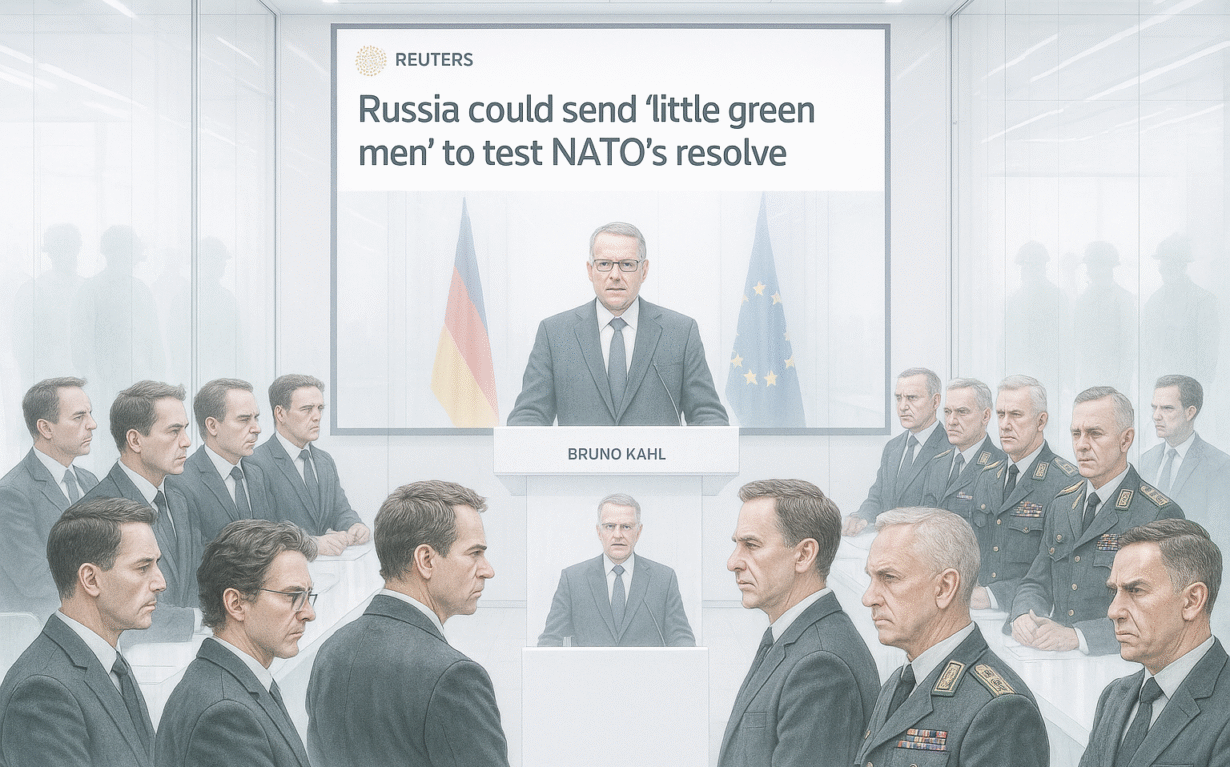How Symbolic Threats Trigger Real Escalation
On June 9, 2025, a headline emerged from Reuters: “Russia could send ‘little green men’ to test NATO’s resolve.” The source was Bruno Kahl, head of Germany’s Federal Intelligence Service (BND), who publicly warned that Russia might deploy covert operatives or irregular forces—similar to the unmarked soldiers used in Crimea in 2014—to destabilize NATO member states. No hard evidence was offered. No immediate incident had occurred. Yet the message reverberated through headlines, official responses, and public discourse.
The warning, in truth, was not designed to trigger action. It was designed to perform significance. And in that sense, it succeeded.
Decisions by Many, Driven by Recognition
Political decisions—especially those concerning security—are rarely the product of one actor. They emerge from bureaucratic systems, intelligence circles, political factions, media advisors, and coalition partners. In such systems, each contributor is driven not only by duty or fact, but by a subtler, more primitive force: the demand for recognition.
- Intelligence agents seek relevance and credibility.
- Politicians seek visibility, strength, and reelection.
- Journalists seek engagement and traffic.
- Military institutions seek funding and prominence.
Each layer of the decision-making hierarchy contributes its voice with an unconscious bias: to not be ignored. Thus, when a vague threat is introduced—such as Russia possibly sending “little green men”—the system does not slow down for analysis. It accelerates into performance. It amplifies.
How Recognition Becomes Reality
Let us break the cycle:
- An intelligence figure issues a speculative warning.
Not because it is certain, but because issuing it maintains visibility and signals relevance. - Media—Reuters in this case—reports it prominently.
The story includes no new evidence but leverages the authority of the source. The phrase “Reuters could not independently verify the claim” serves as a disclaimer, but its effect is diluted by the weight of the headline. - Public imagination is triggered.
The phrase “little green men” is visceral. It evokes memory, anxiety, and cinematic threat. Social media reacts, politicians respond, and the narrative begins to spiral. - NATO and national governments must now perform reassurance.
They signal unity. Troops are shuffled, statements are made, intelligence is reprioritized. Not because of a confirmed threat—but because a threat was said aloud.
Recognition becomes a force multiplier. Every participant contributes not to calm, but to spectacle—because to stay invisible is to lose position.
Reuters and the Role of Media Performance
Reuters did not fabricate the news. But it did perform it. By elevating a vague warning to headline status, it transformed a speculative scenario into a social event. The public’s awareness was not passive—it was constructed.
And yet, Reuters retains the appearance of neutrality:
Reuters could not independently verify the claims.
This phrase acts as a shield, not a limitation. It says: We’re not responsible for the message—only for its visibility.
But in today’s recognition economy, visibility is impact. There is no such thing as neutral transmission. The media outlet becomes a recognition amplifier, validating institutional anxieties and becoming a gear in the policy-making machine. Politicians cite the headline; generals prepare for the scenario; the public anticipates an invisible enemy.
The Risk of Symbolic Intelligence
This kind of performance-based warning carries several real-world dangers:
- Escalation: A vague signal interpreted as imminent threat may lead to unnecessary military movements or confrontation, particularly in the ambiguity-rich Baltic region.
- Alliance Stress: NATO members may disagree on how serious the warning is. Hawkish governments act decisively; others hesitate. Unity frays under symbolic pressure.
- Public Anxiety and Fatigue: Civil populations live in a state of low-level alarm. The language of suspense—“testing resolve”—invites fear but provides no clarity. Over time, trust in governance erodes or turns to numbness.
- Intelligence Credibility Collapse: When vague threats fail to materialize, future valid warnings risk being ignored. The intelligence community, in seeking recognition, undermines its own authority.
- Russian Strategic Validation: By reacting to a speculative tactic, NATO legitimizes Russia’s hybrid warfare methods. In a way, the West performs exactly as Russia would hope.
In short, a warning with no form creates responses with no structure.
Eidoism: A Lens Beyond Performance
Eidoism warns of precisely this pattern: the substitution of formless recognition loops for structural rationality. In this case, form would ask:
- What structural protocols are in place if such hybrid tactics emerge?
- What historical evidence supports the likelihood of this scenario?
- What diplomatic or psychological levers could de-escalate such a provocation?
Instead, performance asked:
- What headline will make us appear alert?
- What phrase will resonate?
- How can we stay visible in the theater of threats?
The answer: little green men.
The Echo Chamber of Fear
This episode reveals a dangerous evolution in geopolitics. The systems meant to protect us—intelligence, media, military, governance—have become participants in a recognition economy that rewards appearance over action, narrative over structure.
A warning is issued not to guide policy, but to signal presence.
Media reports it not to inform, but to engage.
Governments respond not to manage risk, but to be seen managing.
The loop tightens.
And somewhere, in a control room in Moscow, someone watches—smiling—not because they have acted, but because the West has acted as if they had.
The little green men may never come.
But the shadows they cast are already moving the world.


